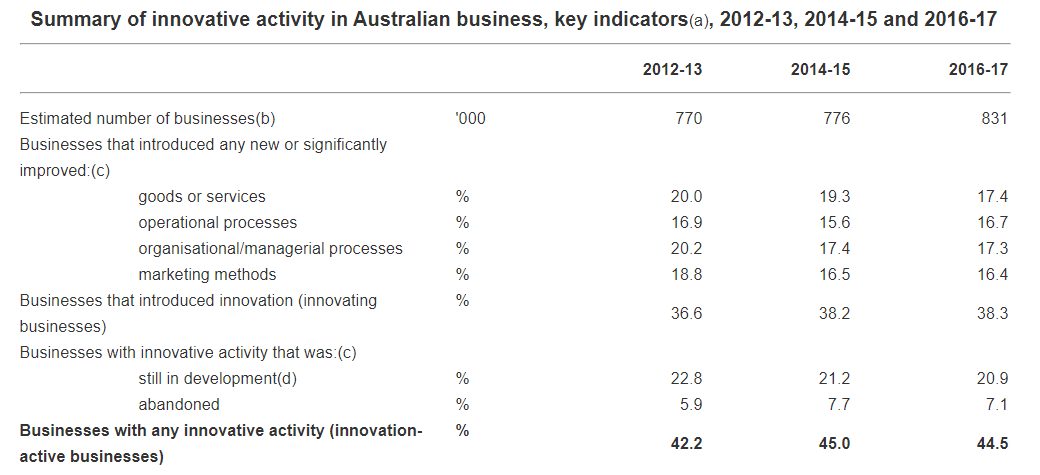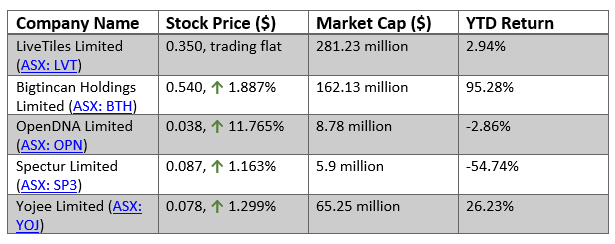If you follow technology news in any format, you would be well acquainted with the buzz words encircling it- Artificial Intelligence (AI) and Big Data. These trending hot topics in the tech space are profound examples of the fact that the tech boom is here to stay, in a rapidly evolving world with newer and more progressive methods and technical advancements.
In this article, we would graze over the concepts of AI and Big Data and look at the performance of a few stocks trading on the Australian Securities Exchange, of the companies that comprehensively use these technologies.
However, before that, let us look at these facts laid down by the Australian Bureau of Statistics (ABS), which proves that the innovation in the Australian businesses has taken a gigantic leap in the past few years:
Innovation in the Australian Business- ABS Statistics
In July 2018, ABS notified that of the goods and/or service innovations implemented in Australia in 2016-17, 8% were new to the world. Nearly, half of all innovation-active businesses spent between $1 and $25,000 on any innovation activity (49%), with acquisition of machinery, equipment or technology proving to be the most common innovation expenditure (43%).
It should be noted here that as innovation is often seen as a continuous process and aspects can be intangible, it can be difficult to measure. However, Australia has been on the uptrend of this concept.

(Source: ABS)
Artificial Intelligence- The Concept
The AI Revolution is growing in strength and popularity across economies. Most researchers believe that in the years to come, a major chunk of companies would have adopted at least one kind of AI technology, which consequently would have a significant impact on the worldâs economy and job-force.
So, what is AI? In simple words, AI is the technology that brings with it, a promise of genuine human-to-machine interaction. The technology makes a machine so intelligent, that it can understand requests, connect data points and draw conclusions. As an icing on the cake, AI aims to allow machines to even reason, observe and plan. In a nutshell, AI can be described as the broad science of mimicking human abilities.
Originally formulated to make computers more useful and more capable of independent reasoning, its history dates back to the 1950s where it sprung in a workshop at Dartmouth College. The initial motive was to merely aid problem solving and symbolic methods. A few years later, advancements were made with the focus on training computers to mimic human reasoning.
Understanding Big Data
Conventionally, Big Data refers to a collection of data which is too huge (as the name suggests) to be handled effectively and efficiently by traditional database tools and methods. Back in time, technologists were aware of these huge batches of user data, and other data types were full of insights that could possibly be extracted by studying the data in large aggregates. However, there was a dearth of cheap, simple technology to organise this approach.
To aid with the issue, US-based John Mashey popularised the term in the 1990s, and presently, the term refers to the use of predictive analytics, user behaviour analytics, or other advanced data analytics methods that extract value from data. In recent years, the amount of available data has been growing in an exponential pace. The concept of Big data is best understood through the 3 Vâs- volume, velocity, and variety.
Volume is the size of data being collected, Velocity is a problem that flows naturally from the volume characteristics, whereas Variety refers to the source and type of data that is being collected. It should be noted that Big Data is not just about the data itself, but the way that it is handled (using relational databases, MapReduce, Hadoop, or NoSQL Databases).
The Difference between AI and Big Data
AI and Big Data are considered to be the two mechanical giants by data scientists. AI has existed for over a decade, whereas Big Data is a relatively newer concept. Let us chalk out the differences between these concepts before we further understand their amalgamation and potential to enhance the tech space:
|
Artificial Intelligence |
Big Data |
| AI is the output, the intelligence that results from the processed data | Big Data is the raw input that needs to be cleaned, structured and integrated before it becomes useful |
| AI is a form of computing that allows machines to perform cognitive functions | It is merely old-style computing |
| AI is about decision making, and learning to make better decisions | Big Data is primarily about gaining insight |
The Powerful Combination of AI and Big Data
A fundamental need of the companies that aspire to transform themselves digitally is the need to store, manage, and study huge quantities of data from a hoard of sources.
Some of the fastest growing companies of the world, like Amazon, Netflix, Salesforce and Alphabet use AI for their core business (to aid them in domains like healthcare, autonomous vehicles, cybersecurity, robotics etc.).
Parallelly, the massive data collections have been on a rise, and it is estimated to only get bigger. Big Data as a concept is gaining traction with evolving businesses, concepts and cross-border activities.
This is where the two technologies intersect and have caused an optimistic convergence. To understand in a nutshell- Data is the fuel that powers AI. The combination of AI and Big Data is a vital development that is shaping the future of how firms drive business value from their data and analytics capabilities. Let us understand how:
- AI needs data to build its intelligence, particularly machine learning;
- Large data sets make it possible for machine learning (an AI branch) applications to learn independently and rapidly;
- AI enables us to make sense of massive, unstructured data sets and aids companies to create new insights from data;
- The more data an AI app has, the more accurate outcome it can achieve;
- Industry experts believe that presently, the world has more than enough anonymised data to train the system, and the focus should shift towards honing AI to extract the maximum value from the data.
ASX-Listed Related Stock Performance
Given the tech-boom in upward direction in Australia, ASX has a hoard of companies that make use of AI and Big Data that have been successful in catching the investorsâ attention. Listed below are a few such stocks, and their current performance on the exchange (as on 10 October 2019, at AEST 1:30 PM):
 As understood, AI and Big Data are two of the emerging technologies that are used by businesses extensively, with the aim to provide better customer experience in an organised and smarter way. To up their game, companies can blend the two concepts to provide a seamless experience to users and offer customers with the best-optimised services.
As understood, AI and Big Data are two of the emerging technologies that are used by businesses extensively, with the aim to provide better customer experience in an organised and smarter way. To up their game, companies can blend the two concepts to provide a seamless experience to users and offer customers with the best-optimised services.
Disclaimer
This website is a service of Kalkine Media Pty. Ltd. A.C.N. 629 651 672. The website has been prepared for informational purposes only and is not intended to be used as a complete source of information on any particular company. Kalkine Media does not in any way endorse or recommend individuals, products or services that may be discussed on this site. Our publications are NOT a solicitation or recommendation to buy, sell or hold. We are neither licensed nor qualified to provide investment advice.



